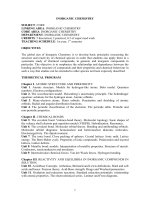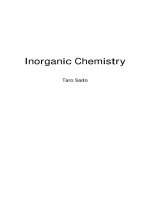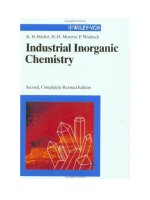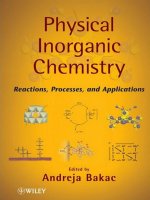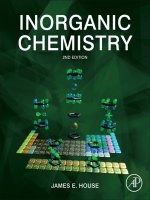Experimental report subject inorganic chemistry
Bạn đang xem bản rút gọn của tài liệu. Xem và tải ngay bản đầy đủ của tài liệu tại đây (4.23 MB, 37 trang )
<span class="text_page_counter">Trang 1</span><div class="page_container" data-page="1">
VIETNAM NATIONAL UNIVERSITY, HO CHI MINH CITY HO CHI MINH UNIVERSITY OF TECHNOLOGY
FACULTY OF CHEMICAL ENGINEERING
EXPERIMENTAL REPORT Subject: Inorganic Chemistry
Instructor: Nguyễn Tu n Anhấ Classcode: CC04-VC02
GROUP 8:
1. Nguy n Th Minh Ngễịọc 2052187 2. Tr n Tu n Nguyên ầấ2053281 3. Lâm Tuy t Nhi ế2053300
Ho Chi Minh City, January 82022
</div><span class="text_page_counter">Trang 2</span><div class="page_container" data-page="2">UNIT 2: ALKALINE EARTH METAL (IIA) I. EXPERIMENTAL RESULTS
Experiment 1: Flame color test
on an alcohol lamp. The flame has an orange-red color.
Perform similarly with:
</div><span class="text_page_counter">Trang 3</span><div class="page_container" data-page="3">Explain the phenomenon: The metal ion of the salt absorbs energy from the flame, the electrons in the outermost shell are excited to a higher energy level. So when it returns to the ground state, it will emit radiation with wavelengths in the specific visible region that represents each metal ion and has a different color.
When igniting alkaline earth metal cations (in compounds with suitable anions) the flame has a characteristic color. In the main subgroup of group IIA, when going from top to bottom, the specific color of the flame will change from red to yellow, which means the energy increases gradually due to the increasing atomic radius, and the electrons easily move to a higher energy level.
Experiment 2: Reaction of alkaline earth metal and water
Take 2 tubes and add in each tube 2 ml of water, a little Mg powder, and 1 drop of phenolphthalein.
• Tube 1:
▪ When cooled
The reaction occurs very slowly. At the phase contact surface, a light pink color appears. Air bubbles emerge, which is hydrogen gas. ▪ When heated
</div><span class="text_page_counter">Trang 4</span><div class="page_container" data-page="4">Air bubbles appear more. The color is darker pink and spread throughout.
Explain the phenomenon:
-Mg and water.
decreases. Therefore the reaction (1) occurs faster, and more air bubbles are released.
solution fades to loss of color, and more gas is released. Then the pink color reappears.
Explain the phenomenon:
making the reaction (1) more intense and the gas released more.
</div><span class="text_page_counter">Trang 5</span><div class="page_container" data-page="5">Mg(OH)<small>2</small> + NH Cl MgCl + NH<small>423</small>± + H<small>2</small>O
Because Mg(OH)2 is dissolved, the balance (2) is shifted to the right, reducing OH- leading to phenolphthalein color loss.
and OH- is produced by reaction (2).
Alkali-earth metals are weakly reactive with water at room temperature, but react strongly when heated or with a suitable catalyst.
• Tube 1: React with acid (HCl). The precipitate dissolves, and the solution becomes transparent.
• Tube 2: React with base (NaOH). No phenomenon occurs
solution with an unpleasant odor.
b) Preparation and properties of alkaline earth metal hydroxide
<small>-2</small>³
</div><span class="text_page_counter">Trang 6</span><div class="page_container" data-page="6">The atomic radius from Mg to Ba increases gradually, so the attraction to the nucleus with the outermost electron decreases. And because oxygen has a large electronegativity, it withdraws electrons more towards it, making the hydroxide molecule strongly polar, so it creates a polar solvent.
Hydroxides of alkaline earth metals are basic. By reacting their soluble salts with alkali metals, it is possible to prepare hydroxides of alkaline earth metals. Experiment 4: Solubility of sulfate alkaline earth metal salt
completely consistent with their solubility product constants.
The solubility of hydroxides and sulfate salts from Mg to Ba is the opposite because, for sulfate salts, the activation energy of the cation is greater than the lattice energy.
</div><span class="text_page_counter">Trang 7</span><div class="page_container" data-page="7">water decreases, and the hydrate energy decreases, so the solubility decreases from Mg to Ba.
Experiment 5: Determine the water hardness
Pipette 10ml of hard water solution into 250ml erlen. Then, add distilled water to obtain the total volume of 100ml. Add 5 ml of pH 10 buffer and about 7 drops of ERIO-T indicator. Shake well and titrate with ETDA 0.02N solution until the indicator changes from purple-red to light blue. Perform the titration twice.
V<small>sample </small>= 10 ml C<small>N ETDA</small> = 0.02 N
</div><span class="text_page_counter">Trang 8</span><div class="page_container" data-page="8">Experiment 6: Soften the hard water
calcium hydroxide slurry. Boil mixture in 3 minutes and filter to remove the precipitate. Use this mixture (10ml) to titrate with a similar procedure as experiment 5.
V<small>sample</small> = 50 ml
</div><span class="text_page_counter">Trang 9</span><div class="page_container" data-page="9">UNIT 6: HYDROGEN-OXYGEN- SULFUR I. EXPERIMENTAL RESULTS
Experiment 1: Preparation of hydrogen gas
Install the air collection system.
Put 3 zinc beads in a test tube, then add 5ml concentrated HCl solution. Collect the gas produced with a small test tube filled with water upside down in a small basin filled with water. Zinc gradually dissolves, creates many bubbles, and generates a lot of heat.
Ignite the hydrogen gas released at the top of the pipe with a slight explosion, a yellow flame, and at the same time give off a lot of heat.
Take the wall of a dry glass funnel and rub it on the fire. There is steam moving up the wall of the funnel.
Explain the phenomenon:
</div><span class="text_page_counter">Trang 10</span><div class="page_container" data-page="10">Because hydrogen reacts with oxygen mixed in the test tube and the gas pipeline, there is an explosion. Initially, the amount of oxygen was more, so there was a loud explosion.
2 H + O <small>22⎯³t</small>
H<small>2</small>O
The steam formed meets the cold glass and condenses.
Hydrogen can be produced by the reactions of active metal with a strong acid.
is approximate 2:1, the explosion is the biggest.
Experiment 2: Activity of hydrogen molecules and hydrogen atom
well and divide into 3 tubes. Tube 1: Used as a standard tube.
Tube 2: Let the hydrogen gas flow through. The color of the solution fades but does not disappear.
Hydrogen in test tube 2 is molecular hydrogen without strong reducing properties, so it does not react with KMnO4. The solution is a little pale because in the solution when there is still a new hydrogen atom, not yet combined into a molecule. Tube 3: Add some zinc particles. Zinc dissolves, bubbles appear, the solution pales and becomes transparent.
The newly born hydrogen is atomic hydrogen, which is a strong reducing agent, so it reacts with KmnO4 to discolor the solution. The gas is produced when unreacted atomic hydrogen combines to form molecular hydrogen.
</div><span class="text_page_counter">Trang 11</span><div class="page_container" data-page="11">Experiment 3: Preparation of oxygen gas
the air collection system. Heat the test tube and collect the escaping gas in the water-filled layer upside down in the water bath.
2 KClO <small>3</small>⎯ ³<small>MnO2</small>⎯<small>,t</small>
Experiment 4: Property of oxygen gas
- Take a little of burning Sulphur in the first tube of oxygen. It bursts into violet-blue flame.
Sulfur has a strong affinity with oxygen. So it can burn in the air with the violet-blue flame.
- Insert a glowing splint into the second tube of oxygen. It bursts into flame. The reaction is strongly exothermic.
The tube that has a large amount of oxygen will increase the rate of reaction. At a high temperature, carbon has a strong reducing property. Thus, it reacts strongly with oxygen.
<small> </small>CO<small>2</small>±
</div><span class="text_page_counter">Trang 12</span><div class="page_container" data-page="12">- Heat the copper wire and insert it into the third tube of oxygen.
The black layer is due to copper being oxidized by oxygen, forming copper (II) oxide.
Oxygen is a strong oxidizer (especially at high temperature), can easily oxidize metal and nonmetal to produce oxide.
Oxygen is needed for fires to burn.
2 I + H<small>-</small> <sub>2</sub>O<small>2</small> + 2 H I + 2 H O <sup>+</sup>÷ <small>22</small>
a toothpick. The solution is effervescent, with gas escaping. The coals become brighter when being put into the tube, which proves that there is oxygen.
Experiment 6: Reaction of Sulfur (S) and Copper (Cu)
</div><span class="text_page_counter">Trang 13</span><div class="page_container" data-page="13">Put 1g sulfur in a porcelain bowl, bring to a boil. Use tongs to put the heated copper wire into the mouth of the upper porcelain cup. The copper wire turns black, with white smoke rising.
Cu(s) +S(g) CuS(s) ² <small>(black)</small>
White smoke is caused by evaporating sulfur
Sulfur has strong oxidizing properties at high temperatures. The sulfur acts as an oxidizing agent in the above reaction. Experiment 7: Reduction of thiosulfate salt
1:2). The solution is colorless. Then it turns turbid.
Sulfur makes the solution cloudy.
</div><span class="text_page_counter">Trang 14</span><div class="page_container" data-page="14">II. ANSWER THE QUESTIONS
1. Compare the activity of hydrogen molecules and atom. Explain? Write the
Atomic hydrogen is a stronger reducing agent than molecular hydrogen. The newly born hydrogen is atomic hydrogen with strong reducing properties, so this compound reacts with KMnO4 to make a colorless solution. Gas is produced when unreacted atomic hydrogen combines to form molecular hydrogen.
<small>2</small>O 2. The important reaction of Oxygen
An important reaction of oxygen is oxidation, especially the combustion reactions
C + O CO <small>2</small>² <small>2</small>
C H O<small>6 12 6</small> + 6 O 6 CO + 6 H O <small>2</small>² <small>22</small>
peroxide in a cool, dark place, open only when needed. And when opened, keep the original brown bottle, which is designed to limit the light in to decompose it
</div><span class="text_page_counter">Trang 15</span><div class="page_container" data-page="15">so Thiosulfate is a strong reducing agent and readily decomposes in acidic sulfur-forming environments.
Oxidation number of S in Thiosulfate is +2
</div><span class="text_page_counter">Trang 16</span><div class="page_container" data-page="16">UNIT 8: Cu Ag - Au METAL (IB) – I. EXPERIMENTAL RESULTS
to react with all the amount of CuO.
Heat the mixture until CuO is empty, filter the mixture if Cu still remains. Concentrate the mixture until crystal seed appearance (without stirring).
vacuum filter (without using water in the filter process).
droplets of NaOH 2M until precipitation appearance. Filter to keep precipitation. A
a) Tube 1: Heat carefully.
Heating copper hydroxide produces copper oxide, CuO, a black solid: <small>The mixture (left) is concentrated and CuSO4.5H2O (right).</small>
</div><span class="text_page_counter">Trang 17</span><div class="page_container" data-page="17">Cu(OH)<small>2</small> (s) ² CuO (s) + H O (l) <small>2</small>
b) Tube 2: Add high concentration HCl and heat carefully (with stirring).
CuCl<small>2</small> + Cl <small>-</small>² [CuCl<small>4</small>]<small>2-</small>
c) Tube 3: Add 4ml NaOH 40% and heat.
The precipitate dissolves and turns into a blue-purple-coloured solution.
</div><span class="text_page_counter">Trang 19</span><div class="page_container" data-page="19">Experiment 5: Reaction of CuSO<small>4 </small>and AgNO<small>3</small> with KI Prepare 2 tubes:
Add drop by drop KI solution into 2 tubes and heat them.
• Tube 1: A yellow precipitate forms. Then it turns into earth-brown color. • Tube 2: A yellow precipitate forms. The color remains after being heated.
Experiment 6: Property of the precipitation Prepare 2 tubes:
Add drop by drop NaOH 2M solution into 2 tubes and heat them.
<small>Tube with CuSO (left) and AgNO (right) afterwards43</small>
</div><span class="text_page_counter">Trang 20</span><div class="page_container" data-page="20">CuSO<small>4</small> + NaOH ² Cu(OH) ³ + Na<small>22</small>SO<small>4</small> • Tube 2: A brown precipitate forms (AgOH).
Collect the precipitation and separate it into 4 tubes (each precipitation in 2 tubes)
green solution.
• Tube 1.2 (reacting with NH4OH): the precipitate slowly dissolves and becomes a blue solution.
• Tube 2.1 (reacting with HNO3): the precipitate dissolves and turns into a white solution. AgOH is unstable and easily dissolves in water:
</div><span class="text_page_counter">Trang 21</span><div class="page_container" data-page="21">Metals from Group IB are amphoteric but weak, easy to create complex substances with ammonia solution.
Experiment 7: Property of the Silver salt
• Tube 1: Add 10 droplets NaCl 0.1M solution. A white precipitate forms
• Tube 1: The precipitate dissolves to create a colorless solution.
• Tube 2: The precipitate partially dissolves.
• Tube 3: The precipitate hardly dissolves.
The colors of the precipitates become darker from Cl to I. The dissolubility decreases from AgCl, AgBr to AgI because of increasing anion radius. Experiment 8: Silver mirror reaction
10% solution, a precipitate appears then gradually dissolves.
</div><span class="text_page_counter">Trang 22</span><div class="page_container" data-page="22">Then, add 5 droplets of HCHO 40% solution and heat the tube at 50 C. A white Ā precipitate forms.
II. ANSWER THE QUESTIONS
1. Why do metals in groups IA and IB have different properties despite a similar outer layer structure with one electron?
Although the metals in groups IA and IB have a similar outer layer structure with one electron, their properties are very different. The reason is that the barrier effect of IB metals is weaker than that of IA metals, leading to their higher first ionization energy. Consequently, the IB metals are less active than the IA metals.
2. Cu preparation from malachite equations?
<small>A white precipitate appears after adding 5 droplets of HCHO 40% solution </small>
</div><span class="text_page_counter">Trang 23</span><div class="page_container" data-page="23">UNIT 10: CHROMIUM I. EXPERIMENTAL RESULTS
Add drop by drop the diluted NaOH solution into 2 tubes. Collect the precipitation by centrifugation.
• Tube 1: Reaction with the dilute acid.
• Tube 2: Reaction with the excess of dilute NaOH solution.
</div><span class="text_page_counter">Trang 24</span><div class="page_container" data-page="24">
Experiment 5: Equilibrium between chromate and dichromate
ions.
Add drop by drop NaOH 2N solution into the tube until its color changes. The color
H<small>+</small> + OH H<small>-</small>³ <small>2</small>O
</div><span class="text_page_counter">Trang 25</span><div class="page_container" data-page="25">The equilibrium of chromate and dichromate ion: 2CrO + 2H<small>4</small><sup>2-</sup> <sup>+</sup> ⇄ Cr<small>2</small>O<small>7</small><sup>2-</sup> + H O <small>2</small>
water, it forms an orange solution. The colors come from the negative ions:
equilibrium with each other in an aqueous solution. Experiment 6: Solubility of chromate salt
0.5N.
</div><span class="text_page_counter">Trang 26</span><div class="page_container" data-page="26">Pb(NO )<small>3 2</small> + K<small>2</small>CrO<small>4 ³</small> PbCrO<small>4ÿ</small> + 2KNO <small>3</small>
with silver nitrate, a brown-red precipitate of silver chromate is formed along with potassium nitrate.
each tube. Tube (1) partially dissolves, tube (2) dissolves fast, tube (4) and (5) hardly dissolves.
<small>2-Tube 1 (leftmost) to tube 5 (rightmost)</small>
<small>Tube 1 (leftmost) to tube 5 (rightmost) after adding 1ml CH3COOH</small>
</div><span class="text_page_counter">Trang 27</span><div class="page_container" data-page="27">CrO<small>4</small> + 2H Cr⇄ <small>2</small>O<small>7</small> + H O <small>2</small>
Chromates (CrO42-) are usually insoluble. Exceptions include Na2CrO4, K2CrO4, (NH4)2CrO4, and MgCrO4.
</div><span class="text_page_counter">Trang 28</span><div class="page_container" data-page="28">UNIT 12: TRANSITION METAL (GROUP VIIIB) Fe Co Ni ––
I. EXPERIMENTAL RESULTS
Experiment 1: Preparation of Mohr salt (NH₄)₂Fe(SO₄)₂·6H₂O
Hydrogen. The solution is black.
The solution was black because Fe was contaminated.
Boil in a fume hood until the iron completely dissolves, the solution turns
of the solution constant. Filter the solution.
Cool and allow to crystallize at room temperature. Vacuum filtration obtains a
The Mohr salt solution reacts with:
</div><span class="text_page_counter">Trang 29</span><div class="page_container" data-page="29">- Diluted KMnO / H<small>42</small>SO<small>4</small>: The solution has a color of light yellow.
add 2-3 drops of 0.5N KI, dark purple precipitate appears. 2 Fe + I Fe + I <small>3+ -2+</small> <sub>2</sub> <sub>(dark purple) </sub>
When KI excess, the precipitate dissolves, producing a brown solution that makes starch glue blue.
</div><span class="text_page_counter">Trang 30</span><div class="page_container" data-page="30">• Tube 1: 2 drops 0.01N NH SCN solution. The solution turns to blood <small>4</small>
When shaking, the liquid becomes turbid and bright blue due to the dispersion of the blue precipitate through the liquid. The color of cobalt (II) hydroxide quickly changes from blue to pink. The pink material also can be written as hydrous
• Tube 1: Heat and place in the air. The color of the precipitate changes to dark chocolate-brown.
chocolate-brown.
tubes. An apple-green precipitate appears.
• Tube 1: Place in air. The color of the precipitate does not change.
</div><span class="text_page_counter">Trang 31</span><div class="page_container" data-page="31">• Tube 2: Add some droplets of H<small>2</small>O<small>2</small> 3% solution. The color of the precipitate changes to black.
The stability of divalent compounds increases, stability of trivalent compounds decreases from Fe to Ni. Divide the precipitate into two parts.
▪ Tube 1.1: React with concentrated HCl solution ² The precipitate is dissolved, producing colorless solution.
appears.
Divide the precipitate into two parts.
▪ Tube 2.1: React with concentrated HCl solution ² The precipitate is dissolved, forming yellow solution.
The dispersion of the blue precipitate through the liquid causes the liquid to
</div><span class="text_page_counter">Trang 32</span><div class="page_container" data-page="32">become turbid and vivid blue when shaken. Cobalt (II) hydroxide rapidly changes color from blue to pink.
Divide the precipitate into two parts.
▪ Tube 3.1: React with concentrated HCl solution ² The precipitate is dissolved, forming reddish-pink solution.
appears.
<small>-2(apple-green)</small> Divide the precipitate into two parts.
▪ Tube 4.1: React with concentrated HCl solution ² The precipitate is dissolved, forming brown solution.
in the alkaline solutions.
<small>2</small>
</div>